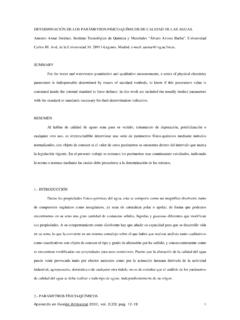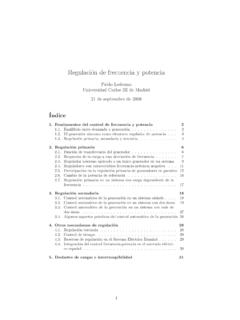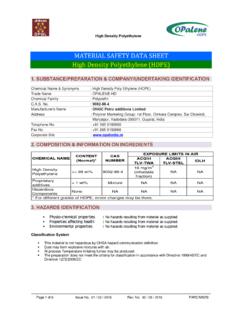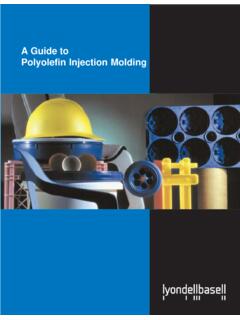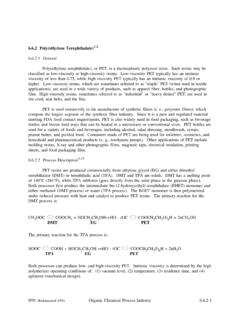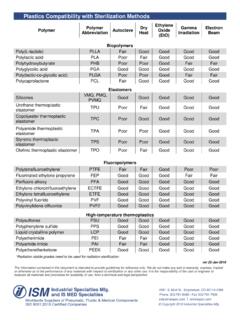Transcription of TOPIC 7. Polymeric materials - UC3M
1 TOPIC 7. Polymeric materials (I). Universidad Carlos III de Madrid materials SCIENCE AND ENGINEERING. TOPIC 7. Polymeric materials 1. Introduction Definition General characteristics Historic introduction Polymers: Examples 2. Classification 3. Properties: Structural aspects 4. Solid state Crystallinity Thermal transitions Mechanical behaviour Dpt. materials Sci. and Eng. and Chem. Eng. UC3M Sophia A. Tsipas / Berna Serrano 1. TOPIC 7. Polymeric materials (I). 1. INTRODUCTION: DEFINITION. POLYMER. Organic compound, natural or synthetic, with high molecular weight made of repetitive structural units . Large size chains formed from the covalent union of various monomer units (macromolecule). PLASTIC. 1. Polymer whose fundamental property is plasticity (thermoplastic).
2 It is deformed plastically under the action of pressure andor heat . 2. Mixture (of a polymer with additives) that can be transformed by flowing or moulding in liquid or molten state. Dpt. materials Sci. and Eng. and Chem. Eng. UC3M Sophia A. Tsipas / Berna Serrano TOPIC 7. Polymeric materials (I). 1. INTRODUCTION: GENERAL CARACTERISTICS. Dpt. materials Sci. and Eng. and Chem. Eng. UC3M Sophia A. Tsipas / Berna Serrano TOPIC 7. Polymeric materials (I). 1. INTRODUCTION: HISTORIC INTRODUCTION. Polymers: synthetic and natural materials : Cellulose, starch, proteins, leather , wool , cotton , synthetic fibres of polyesters and polyamides, plastics, rubbers, adhesives etc Production 1995: 110 millions of tons (Spain: 2,6). 2000: 180 millions of tons (Spain : 2,7).
3 HISTORIC BACKGROUND. Origins of Humanity natural products: leather , wool, cellulose . 1838: Vulcanizing of natural rubber 1846 Cellulose nitrate 1870 Celluloid 1907 Bakelite 1920 Macromolecular Hypothesis (Staudinger). 1926 Polyvinyl chloride (PVC). 1933 poly ethylene (PE). 1938-39 Nylon (fibers) y Polystyrene (PS). 1954 Polypropylene (PP). 1960 Applications of Epoxy Resins 198- Polymers of high specifications Dpt. materials Sci. and Eng. and Chem. Eng. UC3M Sophia A. Tsipas / Berna Serrano TOPIC 7. Polymeric materials (I). 1. INTRODUCTION: EXAMPLES. poly ethylene PE: Most popular plastic Polypropylene PP: used as plastic and as fibre Polystyrene PS: economic and resistant. StyrofoamTM: foam of PS. Polyvinylidene fluoride PVDF: high electric and fire resistance Polymethyl methacrylate PMMA: transparent plastic.
4 Substitute of crystal Nylon (polyamides): most common polymers used as fibers Dpt. materials Sci. and Eng. and Chem. Eng. UC3M Sophia A. Tsipas / Berna Serrano TOPIC 7. Polymeric materials (I). 2. CLASSIFICATION. CLASSIFICATION. According to origin According to structure Natural, synthetic Semicrystalline and amorphous According to chemical composition According to Acrylics , vinyls .. polymerization mechanism Addition, condensation According to applications Elastomers, plastics, fibres, adhesives . According to their behaviour with temperature Thermoplastic Thermosetting Dpt. materials Sci. and Eng. and Chem. Eng. UC3M Sophia A. Tsipas / Berna Serrano TOPIC 7. Polymeric materials (I). 2. CLASSIFICATION. According to applications Elastomers. Are materials with very low modulus of elasticity and high extensibility Plastics.
5 Are the polymers in which, when a sufficiently intense force is applied, they irreversibly deform Fibres Present a high modulus of elasticity and low extensibility Coatings. Are substances, normally liquid, that adhere to the surface of other materials Adhesives. Are substances that combine a high adhesion and a high cohesion, According to their behaviour with temperature Thermoplastic. Flow on heating and they become hard on cooling. Their molecular structure presents few (or none) crosslinks. Thermosetting. They chemically decompose when heated, instead of flowing. This behaviour is due to a crosslinked structure Dpt. materials Sci. and Eng. and Chem. Eng. UC3M Sophia A. Tsipas / Berna Serrano TOPIC 7. Polymeric materials (I). 2. CLASSIFICATION.
6 POLYMERS OF GENERAL USE (Commodity). Polymers of high consumption: polyolefins, polyacrylates and methacrylates, polystyrene, PVC, resins ,phenols, urea and melamines, polyesters, polyurethanes, epoxy resins and diverse elastomers TECHNICAL AND ENGINEERING POLYMERS. Good properties between 0-100 C: polyamides, polycarbonates, polyphenylene oxide (PPO), polysulfones, polyphenylene sulpphide (PPS), aliphatic-aromatic polyesters, Polyether ether ketone (PEEK). SPECIAL POLYMERS. High price polymers with outstanding characteristics, liquid crystals of high modulus and advanced composite materials Factors that determine their use : plastic, fibres or as rubber : Flexibility in the chain , intermolecular interactions and grade of regularity in the polymer Dpt.
7 materials Sci. and Eng. and Chem. Eng. UC3M Sophia A. Tsipas / Berna Serrano TOPIC 7. Polymeric materials (I). 3. PROPERTIES. The properties of polymers depend on multiple factors: Molecular Weight & its distribution Structural aspects Crystallinity Monomeric nature (families of polymers). Number of monomeric units ( molecular weight) and its distribution Monomeric functionality (branches and crosslinking). Relative positions of the groups (tacticity and changes in shape). Ordering of the units (sequences). Ordering the positions of the chain branches (crystallinity ). Dpt. materials Sci. and Eng. and Chem. Eng. UC3M Sophia A. Tsipas / Berna Serrano TOPIC 7. Polymeric materials (I). 3. PROPERTIES. The factors that determine the application of the polymer Molecular Branching weight Sequence of copolymers Crosslinking PROPERTIES.
8 State of Tacticity Shape Dpt. materials Sci. and Eng. and Chem. Eng. UC3M Sophia A. Tsipas / Berna Serrano TOPIC 7. Polymeric materials (I). 3. PROPERTIES: MOLECULAR WEIGHT. MOLECULAR WEIGHT. Macromolecular molecular weight : Mn = M0 Xn where: Mn = number-average molecular weight Mo = monomer molecular weight Xn= degree of polymerization (average number of monomer units in a chain). For a polymer distribution of chain longitude or molecular weights : MEAN MOLECULAR WEIGHT Definition of the various molecular weights: Mn = Mi xi Mw = Mi wi Index of polydispersion : Mn = number-average molecular weight Mw = weight-average molecular weight Mi = mean molecular weight in size range i xi= fraction in number of molecules in range i wi= fraction in weight of molecules in range i Dpt.
9 materials Sci. and Eng. and Chem. Eng. UC3M Sophia A. Tsipas / Berna Serrano TOPIC 7. Polymeric materials (I). 3. PROPERTIES: STRUCTURAL ASPECTS. CONFIGURATION STATES. Polymeric molecular chains are NOT strictly straight: 109o Schematic representation of a molecular chain of a simple polymer with various fringes produced from bond rotation : This behaviour provokes the entanglement between chains high elasticity <r> : distance between the extremes of the chain <s2> : mean radius of rotation r Shape change Flexibility Dpt. materials Sci. and Eng. and Chem. Eng. UC3M Sophia A. Tsipas / Berna Serrano TOPIC 7. Polymeric materials (I). 3. PROPERTIES: STRUCTURAL ASPECTS. MOLECULAR STRUCTURE. Linear Branched Crosslinked Dpt. materials Sci. and Eng. and Chem.
10 Eng. UC3M Sophia A. Tsipas / Berna Serrano TOPIC 7. Polymeric materials (I). 3. PROPERTIES: STRUCTURAL ASPECTS. TACTICITY. The best example is polypropylene PP isostatic isotactic polypropylene, has excellent mechanical properties PP syndiotactic PP atactic atactic polypropylene is a wax type material , with very bad mechanical properties Dpt. materials Sci. and Eng. and Chem. Eng. UC3M Sophia A. Tsipas / Berna Serrano TOPIC 7. Polymeric materials (I). 3. PROPERTIES: STRUCTURAL ASPECTS. ISOTACTIC. SYNDIOTACTIC. ATACTIC. Dpt. materials Sci. and Eng. and Chem. Eng. UC3M Sophia A. Tsipas / Berna Serrano TOPIC 7. Polymeric materials (I). 3. PROPERTIES: STRUCTURAL ASPECTS. COPOLYMERS IN SEQUENCE. +. polyethylene Ethylene vinyl acetate poly vinyl acetate (EVA) coplymer Copolymer with random units Copolymer with alternating units Copolymer with block units Graft copolymers Dpt.
